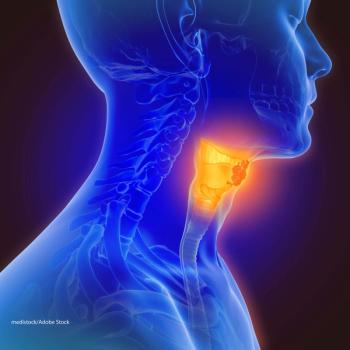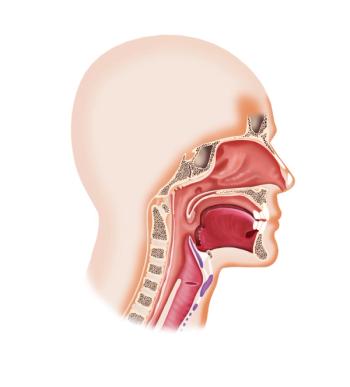
- ONCOLOGY Vol 15 No 10
- Volume 15
- Issue 10
Altered Fractionation for Head and Neck Cancer
A conventional course of radiation for squamous cell carcinoma in the United States is generally 70 Gy in 7 weeks, with a once-daily dose of 1.8 to 2 Gy. This schedule has a modest success rate in curing head and neck cancer. The
The optimal fractionation schedule hasbeen an area of intense clinical research since the beginning of radiotherapy.Over the years, there have been many attempts to improve the outcome ofradiotherapy by altering the overall treatment time, total dose, and number offractions. The majority of clinical trials have tested hyperfractionation,accelerated fractionation, or their variants against "standard"once-daily fractionation. Altered fractionation radiotherapy has been mostextensively studied in the treatment of head and neck cancer.
In this issue, Dr. Adam Garden succinctly reviews therationale for hyperfractionation and accelerated fractionation, as well as theresults of randomized clinical trials of altered fractionation radiotherapy inhead and neck cancer. This will be a valuable reference for all those interestedin this topic.
Improved Locoregional Control With Altered Fractionation
As Dr. Garden points out, the results of randomized trialsthus far suggest that locoregional control in head and neck cancer can beimproved by either an increased total dose (using hyperfractionation) or ashortened overall treatment time (using accelerated fractionation). However,there is no consensus about an "optimal" fractionation schedule.Indeed, the optimal fractionation schedule will be dictated by other practicalconsiderations, such as patient compliance, available resources, and cost.
It should also be noted that the advantage of alteredfractionation radiotherapy is seen primarily in patients with intermediate- toadvanced-stage (stage II-IV) disease. Whether there is any therapeutic gainfor early (stage I) disease has not been evaluated.
Normal Tissue Toxicity
Randomized trials of altered fractionation radiotherapy inhead and neck cancer have consistently shown increased acute toxicity, primarilymucositis. Increased late effects in normal tissues also have been demonstratedwith some accelerated fractionation schedules.
To improve patient tolerance of altered fractionationradiotherapy, methods for reducing normal tissue toxicity are urgently needed.Recent technical advances have led to the development of intensity-modulatedradiotherapy (IMRT). By using radiation beams with variable intensity, IMRTdelivers a dose distribution that conforms the high-dose volume to thethree-dimensional configuration of the tumor target, while sparing nearbysensitive normal tissues.[1-5] Compared with conventional radiotherapy, IMRTdelivers a lower dose at a lower dose per fraction, and thus, a biologicallyless effective dose to the normal tissues than to the tumor. The application ofIMRT, therefore, should reduce normal tissue toxicity when delivering alteredfractionation radiotherapy.
Another approach to reducing toxicity would be the use ofchemical and/or biological toxicity antagonists.[6] For example, growth factorsand cytokines, such as granulocyte colony-stimulating factor (G-CSF [Neupogen]),granulocyte-macrophage colony-stimulating factor (GM-CSF [Leukine]),keratinocyte growth factor (KGF), and transforming growth factor-beta (TGF-beta-3),may diminish the dose-limiting acute toxicity of mucositis caused by alteredfractionation and by radiotherapy with concurrent chemotherapy. The efficacy ofsome of these agents is under active investigation. Pilocarpine (Salagen) andamifostine (Ethyol) are other agents that reduce radiation-induced xerostomia.Whether they also are useful in reducing acute mucositis remains undetermined.
Future Studies
Although locoregional control in head and neck cancer isimproved with altered fractionation, most clinical trials have shown nosignificant improvement in survival to date. On the other hand, recentrandomized trials of concurrent chemotherapy and standard fractionatedradiotherapy have shown increased survival as well as improved locoregionalcontrol.[7,8] A recent meta-analysis of chemotherapy in head and neck canceralso showed a small but significant survival benefit with concurrent but notinduction or adjuvant chemotherapy combined with standard fractionatedradiotherapy.[9] Whether there will be further gain by combining concurrentchemotherapy with altered fractionation radiotherapy remains to be determinedand will be addressed in a future randomized trial by the Radiation TherapyOncology Group.
Normal tissue toxicity, primarily acute toxicity, is expectedto increase with concurrent radiotherapy and chemotherapy, regardless of thefractionation schedule used. To gain patient acceptance of these more intensivetreatments, the need to decrease the side effects and complications usinginnovative radiotherapy techniques, as well as toxicity antagonists, cannot beoveremphasized. Future studies should continue to improve the delivery ofradiotherapy and search for radio- and chemoprotective agents. Improvedunderstanding of the molecular processes underlying radiation andchemotherapy-induced normal tissue injury will help identify the moleculartargets for therapeutic intervention and the strategy for prevention of acuteand late toxicity.
Tumor response to radiotherapy and chemotherapy isheterogeneous. Not all patients will benefit from more intensive radiotherapyand chemotherapy. Reliable clinical and biological predictors are needed for theidentification of patients who will show good response to altered fractionationradiotherapy and chemotherapy. A number of biomarkers of tumor proliferation orangiogenesissuch as overexpression or mutation of p53, expression of Ki 67/MIB-1,HER2/neu, or epidermal growth factor, and p105 antigen and tumormicrovessel densityhave been evaluated for their prognostic significance inhead and neck cancer. Results thus far have been inconsistent, and the roles ofthese biomarkers in predicting tumor response to radiotherapy and chemotherapyremain undefined. It is unlikely that any single biomarker by itself will haveprognostic significance. Treatment outcome may depend on the actions of manyinterrelated factors. In the future, molecular analysis of the genetic profiles ofboth the tumor and the patient may help in selecting the optimal treatmentstrategy for the individual patient.
References:
1. Dawson LA, Anzai Y, Marsh L, et al: Patterns oflocal-regional recurrence following parotid-sparing conformal and segmentalintensity-modulated radiotherapy for head and neck cancer. Int J Radiat OncolBiol Phys 46:1117-26, 2000.
2. Eisbruch A, Ten Haken RK, Kim HM, et al: Dose, volume, andfunction relationships in parotid salivary glands following conformal andintensity-modulated irradiation of head and neck cancer. Int J Radiat Oncol BiolPhys 45:577-587, 1999.
3. Butler EB, Teh BS, Grant WH 3rd, et al: Smart(simultaneous modulated accelerated radiation therapy) boost: A new acceleratedfractionation schedule for the treatment of head and neck cancer with intensitymodulated radiotherapy. Int J Radiat Oncol Biol Phys 45:21-32, 1999.
4. Sultanem K, Shu H-K, Xia P, et al: 3-D Intensity-modulatedradiotherapy (IMRT) in the treatment of nasopharyngeal carcinoma: The UCSFexperience. Int J Radiat Oncol Biol Phys 48:711-722, 2000.
5. Wu Q, Manning M, Schmidt-Ullrich R, et al: The potentialfor sparing of parotids and escalation of biologically effective dose withintensity-modulated radiation treatments of head and neck cancers: A treatmentdesign study. Int J Radiat Oncol Biol Phys 46:195-205, 2000.
6. Trotti A: Toxocity antagonists in head and neck cancer.Semin Radiat Oncol 8:282-291, 1998.
7. Calais G, Alfonsi M, Bardet E, et al: Randomized trial ofradiation therapy versus concomitant chemotherapy and radiation therapy foradvanced-stage oropharynx carcinoma [see comments]. J Natl Cancer Inst91:2081-2086, 1999 (see comments in J Natl Cancer Inst 91:2065-66, 1999; 92:657,2000).
8. Adelstein DJ, Adams GL, Li Y, et al: A phase IIIcomparison of standard radiation therapy (RT) vs RT plus concurrent cisplatin (DDP)vs split-course RT plus concurrent DDP and 5-fluorouracil (5FU) in patients withunresectable squamous cell head and neck cancer (SCHNC): An Intergroup study(abstract 1624). Proc Am Soc Clin Oncol 19:411a, 2000.
9. Pignon JP, Bourhis J, Domenge C: Chemotherapy added to locoregionaltreatment for head and neck squamous-cell carcinoma: Three meta-analyses ofupdated individual data. Lancet 355:949-955, 2000.
Articles in this issue
over 24 years ago
Advances in Cancer Research, Volume 79over 24 years ago
Physician Fee Cuts Also a Possibilityover 24 years ago
Testing Cancer Drugs in Childrenover 24 years ago
Chemotherapy for Resectable and Advanced Pancreatic CancerNewsletter
Stay up to date on recent advances in the multidisciplinary approach to cancer.
































































































